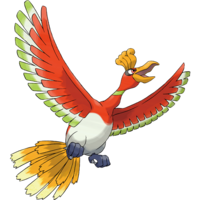From Bulbapedia, the community-driven Pokémon encyclopedia.
|
|

Artwork from Crystal
|
|
|
|
|
|
|
|
|
|
|
|
Height
0'0"
Imperial
|
0.0 m
Metric
|
0'0"/0.0 m
Red-Striped
|
0'0"/0.0 m
Blue-Striped
|
0'0"/0.0 m
|
|
|
Weight
0.0 lbs.
Imperial
|
0.0 kg
Metric
|
0.0 lbs./0.0 kg
Red-Striped
|
0.0 lbs./0.0 kg
Blue-Striped
|
0.0 lbs./0.0 kg
|
|
|
|
|
|
|
|
|
|
|
|
|
EV yield
HP
0
|
Atk
0
|
Def
0
|
Sp.Atk
0
|
Sp.Def
0
|
Speed
0
|
| Base Exp.: 220
|
Battle Exp.: 2201*
|
|
|
| External links
|
| {{Links/{{{generation}}}|pokefordex=ho-oh|ndex=250|name=Ho-Oh }}
|
|
|
Ho-Oh (Japanese: ホウオウ Houou, German, French: Ho-Oh, Korean: 칠색조 Chilsaekjo) is a Fire/Flying-type Pokémon. It is often considered to be closely related to Lugia, even sometimes as its polar opposite, represented by gold as Lugia is represented by silver, and "guardian of the skies" as Lugia is "guardian of the seas".
Base stats
| Stat
|
Range
|
| At Lv. 50
|
At Lv. 100
|
106
|
|
166 - 213
|
322 - 416
|
130
|
|
121 - 200
|
238 - 394
|
90
|
|
85 - 156
|
166 - 306
|
110
|
|
103 - 178
|
202 - 350
|
154
|
|
143 - 226
|
281 - 447
|
90
|
|
85 - 156
|
166 - 306
|
Total: 680
|
Other Pokémon with this total
|
- Minimum stats are calculated with 0 EVs, IVs of 0, and (if applicable) a hindering nature.
- Maximum stats are calculated with 252 EVs, IVs of 31, and (if applicable) a helpful nature.
|
Name origin
It's English name is simply another way of transcribing 鳳凰 Hōō, which is the Japanese word for phoenix, specifically, the Chinese phoenix, or Fènghuáng.
Ho-Oh, like Moltres, is based on the legend of the phoenix; unlike Moltres, it is based on the Fènghuáng. Many cultures view the phoenix as a symbol of resurrection; this is seen in Ho-Oh, which was reborn rising from its own ashes and had a hand in resurrecting Suicune, Raikou and Entei.
In the games
In Pokémon Gold, Silver, and Pokémon Crystal, it flies to the roof of Tin Tower, causing the central pillar to shake, when the games' hero/heroine enters with a Rainbow Wing, one of its feathers. However, the means of obtaining the Rainbow Wing differs between the three versions.
In Pokémon FireRed, LeafGreen, and Pokémon Emerald, Ho-Oh is encountered in Navel Rock, a barren rock in the center of the Sevii Islands, along with Lugia. To reach Navel Rock via a Seagallop Ferry, one must have the Mysticticket, a promotional item.
Sacred Ash, an item that when used fully restores all party Pokémon's HP and status conditions, is considered closely related to Ho-Oh. In Gold, Silver, and Crystal, it is held by Ho-Oh. In FireRed, LeafGreen, and Emerald, it is found in the spot underneath Ho-Oh after defeating
or catching it.
Ho-Oh comes with the Ability Pressure, which causes the foe to use two PP instead of one each time it uses a move.
Ho-Oh's signature move is{{[m|Sacred Fire}}.
Ho-Oh does not evolve, and no Pokémon evolves into it.
In the anime
According to the anime, Ho-Oh lived in Tin Tower in ancient times. But when war broke out, burning Tin Tower down, it created Raikou, Entei, and Suicune, and all four disappeared. Later, a new Tin Tower was erected, but Ho-Oh since then has never come back for sure. Ash however has currently witnessed Ho-Oh at least twice; indeed, it was the first Generation II Pokémon to appear in the anime. Also, a sacred flame burns in Dragon's Den which came from Ho-Oh in the same ancient war that burned Tin Tower; it still burns today, protected in a shrine. In the anime, Ho-Oh was last seen by Ash flying toward Hoenn.

|
This Pokémon article is part of Project Pokédex, a Bulbapedia project that aims to write comprehensive articles on each Pokémon species, as well as Pokémon groups and forms.
|


